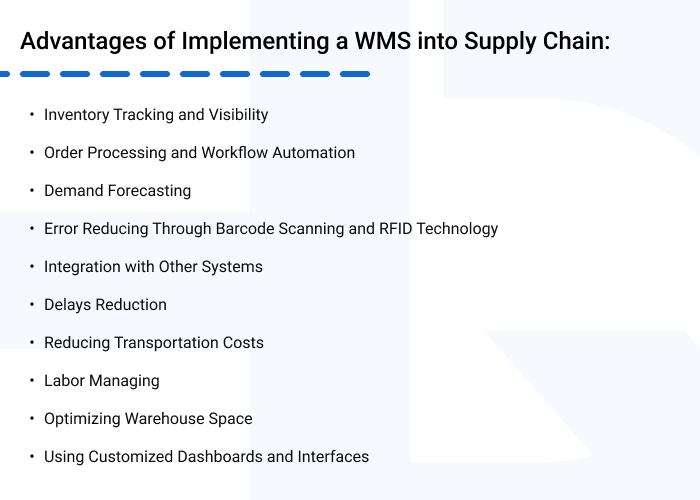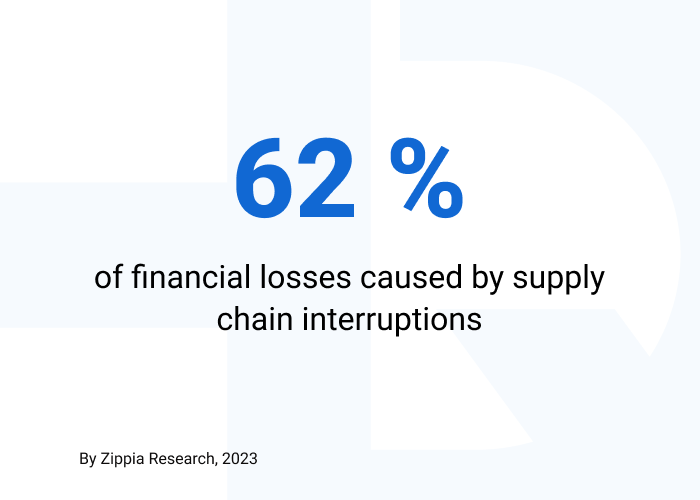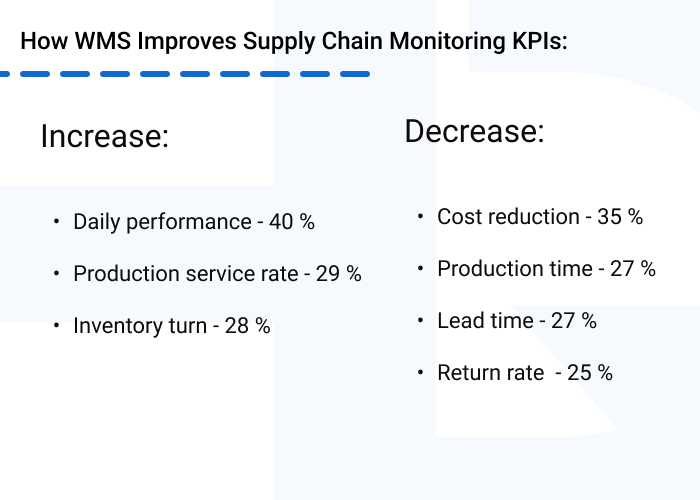How does a WMS help with Supply Chain Management?
Key Supply Chain Management Challenges
Warehouse Management Systems (WMS) can enhance supply chain management by regulating warehouse inventory, shipping operations, and order fulfillment processes. Knowing your inventory down to the last item and how quickly and efficiently it moves through your supply chain is critical to making smart decisions. So, if you’re searching for ways to improve supply chain management for your organization and come out on top in this competitive business, a warehouse management system can be the answer.
Let’s look at how implementing WMS technology into your existing supply chain can benefit both you and your customers.
How does a WMS help with Supply Chain Management?
Key Supply Chain Management Challenges
Using a WMS in supply chain management helps you control the circulation of goods through all stages: receiving, storing, picking, tracking, and delivering. A WMS increases the overall accuracy and efficiency of inventory control, order fulfillment, and shipping. To effectively manage item flow, you can use barcode scanners, radio frequency identification (RFID), and biometrics, which transmit data to the WMS.
A supply chain involves all the procedures necessary to deliver a product from the manufacturer or supplier to the final consumer, including sourcing, manufacturing, logistics, and customer service. It covers each step taken to obtain raw resources, transform them into completed goods, and distribute them to clients.
Supply chain management involves a range of complex challenges that must be addressed to ensure a fast and secure movement of items and services:
To successfully manage your supply chain, you need to make decisions swiftly in response to changing consumer preferences and market conditions. You must ensure that inventory levels are sufficient to meet customer needs, while avoiding overstocking.
Regular data collection and analysis, as well as ongoing updating of forecasts, can greatly increase supply chain accuracy. Using advanced AI analytic tools, you can rely on data history and identify customer needs so as to replenish inventory on time.
Long distances and the multi-stage shipping process may result in unexpected shipping delays. Delaying delivery of items to clients might cause missed deadlines and lost sales, while holding up the delivery of raw materials can slow down the production process.
To reduce the impact of shipping delays, you can track shipments in real-time, keep in touch with suppliers and customers, and create emergency plans.
The cost of transportation, labor, inventory management, and raw materials has increased globally. You may experience delayed or canceled orders, supply shortages, and revenue losses when there is a disruption in the flow of goods and services.
To cut down on logistics and transport costs and shorten lead times, you can implement systems that enable real-time access to inventory and order statuses. Real-time tracking of cargo movement enables route and delivery schedule optimization, reducing travel distances and delivery times, and ultimately transportation costs. So, you can easily control and manage shipment processes and eliminate the likelihood of human mistakes.
Without a centralized supply chain management system and limited data synchronization across multiple platforms, companies with geographically distributed operations may find it difficult to provide visibility to their global operations. According to Zippia research, only 6% of businesses claim to have complete visibility into their supply chains.

Lack of reliable, up-to-date, and comprehensive data can lead to higher expenses, longer wait times, and low customer satisfaction. To overcome these difficulties, you need to implement cutting-edge technological solutions, such as a WMS, for data collecting, storage, and analysis.
Supply chain warehouse management can also help to spot communication problems, as it shares information across different systems, such as enterprise resource planning (ERP), accounting software, transportation management systems (TMS), suppliers, and stakeholders.
Changes in consumer demand, trade conflicts, raw material shortages, economic crises, legal policy changes, etc.—all these are elements of the main supply-chain risks. Between them, you may experience delays in shipping, problems with inventory management, cybersecurity issues, supplier disruptions, etc.
To evaluate supply chain risks, it’s important to have transparency when it comes to inventory levels, order fulfillment times, and delivery schedules. This data will enable you to create risk assessments, find weak points, and create mitigation strategies. Once risks have been identified and assessed, you may create plans to lessen the possibility and impact of interruptions.
To resolve supply chain challenges, you can implement a WMS that will help increase your business profitability while enhancing efficiency, accuracy, and visibility throughout the supply chain procedures.
WMS is essential to supply chain management as it controls how orders are fulfilled, from the receipt of items at the warehouse until they are delivered to the customer. The system ensures that resources and goods are moved through warehouses as efficiently and profitably as possible.
Let’s take a look at the most significant advantages of incorporating a WMS into your supply chain warehouse management.

By implementing a customized WMS in your supply chain, you can manage stock levels in real time, alter inventory, and refresh your planning models with recent inventory data. This way, you can prevent running out of stock or overstocking.
A WMS also supplies on-time updates on stock movements, improving coordination between different departments. You can then share this information with your partners and provide useful feedback.
With a WMS, you can track each order’s position and status, effectively plan delivery times, and therefore reduce order cycle times. You can also monitor every stage of the stock management process using radio frequency identification (RFID) and automated data collection.
With automated data collection, you can gather, process, and store significant amounts of data relating to the items flowing through the chain. This involves automated tracking of inventory levels, product movements, and delivery schedules.
Also, a WMS can help you automate order fulfillment, speeding up repetitive operations and reducing human errors. For example, a system can create efficient picking plans for grouping orders by shipping dates, product category, delivery category, and storage requirements (frozen, fragile, etc.). Then, it offers the most effective routes to pick orders throughout the warehouse. In this way, you can maximize labor efficiency and expedite operational performance.
A WMS implements the predictive analytics feature to forecast customer demand based on market dynamics and trends, seasons, and location. By comparing inventory levels and activities during peak seasons, you can schedule your future replenishments without the risk of overstocking or stock shortages, reducing inventory costs.
Interested in developing a WMS to improve your supply chain operations?HQSoftware has a team of skilled professionals ready to tackle the project. Let’s talk!
Anna Halias
Business Development Manager
A WMS can work in conjunction with barcode scanning and RFID technology to track the location of goods, minimize picking and shipping mistakes, and improve customer satisfaction.
Barcode scanning is the process of reading a product’s barcode label using a handheld device. The WMS receives the scanned data, verifies and updates it in real-time. This helps eliminate errors that occur with manual data entry.
Using RFID, you can calculate and monitor all individual items throughout the supply chain, from the factory where goods are produced to the stores. This allows you to minimize errors caused by loss, destruction, or displacement.
You can integrate a WMS with your internal systems, such as TMS, ERP, accounting software, and POS system. Thus, you will get a flexible, centralized environment to manage your orders and inventory and securely share data across various departments of your enterprise.
By integrating e-commerce platforms into your WMS, you can provide up-to-date information across all channels and automatically manage purchase orders. This allows you to give consumers the ability to check the status of their orders, greatly improving your customer service.
By integrating a WMS, you will be able to monitor the status of shipments from end to end, eliminating redundancies and minimizing delivery errors. You can keep suppliers and customers informed by maintaining regular contact with logistics partners on shipment plans and delivery expectations. So, potential issues can be addressed proactively before they cause delays.

For instance, for one of our clients, the WMS helped increase the number of orders shipped on the same day to 99.4%.
Another way to decrease delays is to evaluate and analyze supply chain procedures and highlight areas that could be enhanced. Using predictive analysis, you can identify potential bottlenecks and inefficiencies and implement strategies to mitigate them.
By implementing a supply chain warehouse management system, you can optimize transportation routes according to delivery schedules and cluster geographic locations.
Using WMS, you can calculate weight, volume, and other limits, optimize used space in a vehicle, and create the most cost-effective routes. With more efficient use of space, you may reduce the number of vehicles needed for transporting goods and therefore reduce transport costs.
The other way to save money is using stock planning to provide the needed products in the required quantities at the right time. This way, you can manage your inventory more efficiently and reduce the need for emergency or incorrect shipments, returns, and reshipments.
Using a WMS, you can analyze history and current labor activities to verify whether there are enough staff members to meet operational demands. Relying on the analyzed information, a WMS can distribute tasks to employees, preventing labor shortages and overstaffing.
You can also use a WMS to train new employees or retrain current employees. The system can create manuals and step-by-step guidelines to help workers learn and master various warehouse tasks. This shortens the learning period and increases labor productivity.
A WMS can analyze and provide advice on the optimal use of floor space, based on the material characteristics of the stored goods. This gives you an opportunity to decrease waste of prime floor space and time needed to locate products.
But before optimizing warehouse space, it’s crucial to perform a complete review of your present inventory levels, product demand, and storage capacity. Using WMS, you can specify the areas for improvement and develop enhancement strategies. This may entail moving shelves, making aisles, or storing things vertically.
A WMS can create customized dashboards to track and analyze key warehouse performance indicators like lead time, order cycle, fill rate, delivery time, and inventory turnover.
With these metrics, you can better understand customer needs, make real-time data updates, and provide alerts for potential issues. Gaining all this information through customizable dashboards, you can improve your decision-making processes to enhance supply chain performance.
With all these advantages of incorporating a WMS, you can profit in terms of financial savings, higher inventory turnover, and priceless insight into the supply chain’s requirements.

By implementing supply chain warehouse management, you can identify inefficiencies within your supply chain processes, avoid shipment delays, improve forecasting strategies to eliminate overstocks, and reduce transportation and operational expenses.
At HQSoftware, we can develop a cutting-edge WMS to help you create a flexible ecosystem and increase the effectiveness of your warehouse management. Over 21 years, we have successfully completed more than 450 projects, including supply chain and WMS systems.
Along with 3PL companies, we work with enterprises and startups, helping them develop best-in-class WMS solutions to lower their expenses and increase warehouse productivity. We provide high-level experts to develop your solution who have actual experience in creating WMS and have worked on projects in your domain.
If you’re looking to develop a WMS to improve your supply chain, don’t hesitate to contact us for a free consultation.

Head of Production
To ensure the outstanding quality of HQSoftware’s solutions and services, I took the position of Head of Production and manager of the Quality Assurance department. Turn to me with any questions regarding our tech expertise.
We are open to seeing your business needs and determining the best solution. Complete this form, and receive a free personalized proposal from your dedicated manager.

Sergei Vardomatski
Founder